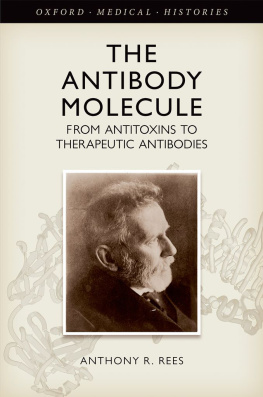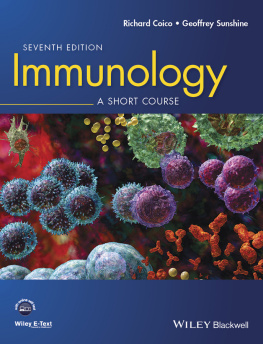The Antibody Molecule
Oxford Medical Histories Series
This series of Oxford Medical Histories is designed to bring to a wide readership of clinical doctors and others from many backgrounds a short but comprehensive text setting out the essentials of differing areas of medicine. Volumes in this series are written by doctors and with doctors, in particular, in mind as the readership.
History describes the knowledge acquired over time by human beings. It is a form of storytelling, of organizing knowledge, of sorting and giving impetus to information. The study of medical history, just like the history of other human endeavours, enables us to analyse our knowledge of the past in order to plan our journey forward and hence try to limit repetition of our mistakes a sort of planned process of Natural Selection, described as being in the tradition of one of the most famous of medical historians, William Osler. Medical history also encourages and trains us to use an academic approach to our studies which thereby should become more precise, more meaningful and more productive. Medical history should be enjoyable too, since that is a powerful stimulus to move forward, a fun thing to do both individually and in groups.
The inspiring book that led to this series introduced us to clinical neurology, genetics, and the history of those with muscular dystrophy. Alan and Marcia Emery explored The History of a Genetic Disease, now often styled Meryons disease rather than Duchenne Muscular Dystrophy. The first to describe a disease process is not necessarily the owner of the eponym but the Emerys are helping put that right for their subject, Edward Meryon. The second book in the series, on radiology, took us on a journey round a world of images.
Thus future volumes in this series of Oxford Medical Histories will continue the journey through the history of our bodies, of their relationship to our environment, of the joyful and the sad situations that envelope us from our individual beginnings to our ends. We should travel towards other aspects of our humanity, always leaving us with more questions than answers since each new discovery leads to more questions, exponential sets of issues for us to study, further thoughts and attempts to solve the big questions that surround our existence. Medicine is about people and so is history; the study of the combination of the duo can be very powerful. What do you think?
Christopher Gardner-Thorpe, MD, FRCP, FACP
Series Advisor, Oxford Medical Histories

Great Clarendon Street, Oxford, OX2 6DP, United Kingdom
Oxford University Press is a department of the University of Oxford. It furthers the Universitys objective of excellence in research, scholarship, and education by publishing worldwide. Oxford is a registered trade mark of Oxford University Press in the UK and in certain other countries
Oxford University Press 2015
The moral rights of the author have been asserted
First Edition published in 2015
Impression: 1
All rights reserved. No part of this publication may be reproduced, stored in a retrieval system, or transmitted, in any form or by any means, without the prior permission in writing of Oxford University Press, or as expressly permitted by law, by licence or under terms agreed with the appropriate reprographics rights organization. Enquiries concerning reproduction outside the scope of the above should be sent to the Rights Department, Oxford University Press, at the address above
You must not circulate this work in any other form and you must impose this same condition on any acquirer
Published in the United States of America by Oxford University Press
198 Madison Avenue, New York, NY 10016, United States of America
British Library Cataloguing in Publication Data
Data available
Library of Congress Control Number: 2014944571
ISBN 9780199646579
eISBN 9780191016165
Oxford University Press makes no representation, express or implied, that the drug dosages in this book are correct. Readers must therefore always check the product information and clinical procedures with the most up-to-date published product information and data sheets provided by the manufacturers and the most recent codes of conduct and safety regulations. The authors and the publishers do not accept responsibility or legal liability for any errors in the text or for the misuse or misapplication of material in this work. Except where otherwise stated, drug dosages and recommendations are for the non-pregnant adult who is not breast-feeding
Links to third party websites are provided by Oxford in good faith and for information only. Oxford disclaims any responsibility for the materials contained in any third party website referenced in this work.
For my wife Marianne and Melissa, Emma, Charlotte, Madeleine,
Lucy, Bruno, and Margo
And in memory of my dear mother
... every effect is a distinct event from its cause... In vain, therefore, should we pretend to determine any single event, or infer any cause and effect, without the assistance of observation and experience.
Reproduced from David Hume, Enquiries concerning the human understanding and concerning the principles of morals., Reprinted from the 1777 edition and edited by L.A. Selby-Bygge, 2nd Edn. 1902, Impression of 1970. Oxford University Press.
Foreword
Another antibody book was the subject line of the email I received from Tony Rees almost a year ago with a request that I consider writing the foreword. From his self-deprecating email one would have thought that Tony was adding to the ponderous pile of texts that have focused on this well-studied and even better documented molecule, texts that range from those purely methodological to those purely didactic. Was there a need for yet another treatise on the antibody? Probably not. However, knowing Tonys work on antibody modelling and engineering as I did, and his intimate association with antibody-based technologies, I suspected something more interesting must have been brewing. Indeed it was. Tony set out to record an historical account of the antibody molecule, from its first description in the late-nineteenth century to our current infatuation with it as a therapeutic entity. What Tony succeeded in doing was to capture a snapshot of the world of immunology and of the personalities that drove the field, moving it from one purely descriptive to one based on molecular principles. His account reads like a mystery novel, with all the drama that can be found with personality clashes, false starts and, at the end, resolution and clarity.
Several themes emerge from this historical perspective of immunology as glimpsed through the antibody molecule. Immunology is, at its heart, a discipline inseparable from the physiology of the organism. It interacts in a dynamic way with every organ system, balancing its protective features with the unavoidable collateral damage that accompanies the inflammatory response. Maintaining this equilibrium is key to survival of the organism; perturbations inexorably lead to pathology. To understand the immune response one needed a holistic approach, a fact widely appreciated by its early practitioners, but eclipsed during periods of reductionist fervour. The pendulum swung up and back throughout the history of the antibody molecule, from in vitro dissection to in vivo biology, coming to rest in this century at a synthesis of the two approaches, with the advent of methods that permitted reductionism at the whole animal level through the use of recombinant DNA technology and the use of genetically modified organisms. Detailed molecular dissection of the antibody molecule, the pathways that generate its remarkable diversity, and the systems that are recruited to mediate its









